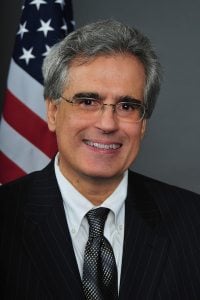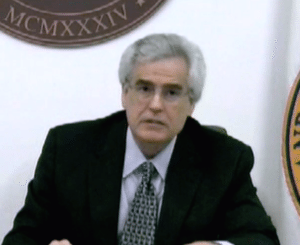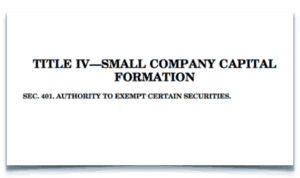 Earlier this month, Commissioner Luis A. Aguilar addressed the Advisory Committee on Small and Emerging Companies in Washing D.C. In his speech (embedded below), Commissioner Aguilar echoed the sentiments of the market in arguing the need for increased liquidity in the private placement market. His speech goes well beyond that point however, as he highlights the weaknesses of the current options and the need for further regulatory reform.
Earlier this month, Commissioner Luis A. Aguilar addressed the Advisory Committee on Small and Emerging Companies in Washing D.C. In his speech (embedded below), Commissioner Aguilar echoed the sentiments of the market in arguing the need for increased liquidity in the private placement market. His speech goes well beyond that point however, as he highlights the weaknesses of the current options and the need for further regulatory reform.
The Problem
The lack of liquidity of privately placed securities has always been a concern for investors but never more than it is today. In the past, privately placed securities had been traditionally offered and sold only to affluent individuals (typically behind closed doors) and those individuals went into the deal knowing that there was no readily available exit for their investment. More importantly, their substantial wealth often allowed them to hold such investments for an indefinite period of time. With the introduction of the JOBS Act however, a whole new breed of investors have been given keys to the kingdom and these investors need liquidity. Moreover, these new investors (on average) differ greatly in both their respective wealth and their financial acumen in comparison to the highly affluent investors of the past. As Commissioner Aguilar noted in his speech:
“[t]he combined results of these existing and pending rules is that companies will be able to sell their securities to a wider swath of the public … As a result, investors who acquire these [securities] —many who are expected to be less financially sophisticated and need not be so-called “accredited investors” —may be left holding shares that they are unable to sell.”
 The reason why privately placed securities are illiquid is because there is no real place to sell them. Unlike traditional stocks and bonds which an investor can generally sell and trade at will in established exchanges (e.g. NASDAQ, NYSE, etc.), there currently is no marketplace to offer and sell most privately placed securities. If an investor wishes to sell his/her/its privately placed securities they must both find someone willing to buy the securities (if possible) and prepare a myriad of legal documents to evidence the sale; not to mention having to satisfy multiple federal and state requirements regarding the securities and/or the purchaser (e.g. holding periods, purchaser qualifications, etc.).
The reason why privately placed securities are illiquid is because there is no real place to sell them. Unlike traditional stocks and bonds which an investor can generally sell and trade at will in established exchanges (e.g. NASDAQ, NYSE, etc.), there currently is no marketplace to offer and sell most privately placed securities. If an investor wishes to sell his/her/its privately placed securities they must both find someone willing to buy the securities (if possible) and prepare a myriad of legal documents to evidence the sale; not to mention having to satisfy multiple federal and state requirements regarding the securities and/or the purchaser (e.g. holding periods, purchaser qualifications, etc.).
These hurdles typically make the sale of privately placed securities by an investor difficult, if not impossible, leaving them with no way to get out of their investment. This lack of an identifiable exit is often a problem for most would-be investors. Wealth and financial sophistication aside, in today’s society it is no wonder why these new investors (while in most cases still substantially well off) are generally less able and/or willing to make an investment that they cannot get out of if their financial situation changes. As a result, to make these types investments more appealing and viable to this new class of investors they need to be made more liquid … but how?
Secondary Markets; Venture Exchanges
 How do you make privately placed securities more liquid? Create a marketplace for these securities of course (i.e. “secondary market”). As stated by Commissioner Aguilar, “[t]he lack of a fair, liquid, and transparent secondary market for these securities is a longstanding problem that needs an effective solution.” However, as the Commissioner also noted, the creation of such a secondary market is easier said than done for multiple reasons.
How do you make privately placed securities more liquid? Create a marketplace for these securities of course (i.e. “secondary market”). As stated by Commissioner Aguilar, “[t]he lack of a fair, liquid, and transparent secondary market for these securities is a longstanding problem that needs an effective solution.” However, as the Commissioner also noted, the creation of such a secondary market is easier said than done for multiple reasons.
The most popular “secondary market” strategy in the industry today is the concept of a “venture exchange.” In the simplest of terms, think of a venture exchange as a stock exchange for small companies. The idea is that (again in the simplest of terms), assuming that the private company you invest in is registered with one of these venture exchanges (and meets all the necessary requirements of such exchange), you would be able to sell your privately placed securities on the exchange much like you could sell stock on the stock market. This all sounds nifty in theory, but there are a lot of variables involved. Most notably, if the company you invest in no longer qualifies to be on the exchange (for any of a number of reasons), or the exchange shuts down (e.g. the “ECM” discussed below), you are back to holding an illiquid investment. As Commissioner Aguilar also aptly noted “[v]enture exchanges are hardly a new idea, however, and prior efforts to establish them in this country have fared poorly.”
 In his speech, the Commissioner briefly touches on certain issues affecting the use and viability of venture exchanges including the demise of the American Stock Exchange’s “Emerging Company Marketplace” (ECM), the currently stalled efforts to create the “Nasdaq BX Venture Market” and the recent struggles being faced by Canada’s new “TSX Venture Exchange.” He uses these examples not to illustrate that venture exchanges don’t or can’t work effectively as a secondary market strategy but that, in order to do so, the “Commission should attempt to determine the underlying causes of these problems and how best to address them.” Put another way, the Commission needs to look at these exchanges in more depth to understand what works and what doesn’t. A sentiment I could not agree with more.
In his speech, the Commissioner briefly touches on certain issues affecting the use and viability of venture exchanges including the demise of the American Stock Exchange’s “Emerging Company Marketplace” (ECM), the currently stalled efforts to create the “Nasdaq BX Venture Market” and the recent struggles being faced by Canada’s new “TSX Venture Exchange.” He uses these examples not to illustrate that venture exchanges don’t or can’t work effectively as a secondary market strategy but that, in order to do so, the “Commission should attempt to determine the underlying causes of these problems and how best to address them.” Put another way, the Commission needs to look at these exchanges in more depth to understand what works and what doesn’t. A sentiment I could not agree with more.
Extending on this idea, Commissioner Aguilar notes certain factors that can improve the effectiveness and viability of venture exchanges including, among others, focusing on investor protection, educating investors and maintaining certain key eligibility standards. What is most clear from his speech is that the Commissioner is apprehensive about approving any new venture exchanges without further research by the Commission.
To be sure, venture exchanges can, and do, attract reputable and profitable companies. But experience has shown that venture exchanges and the companies they list may present more risks than investors realize. The Commission needs to understand how best to address these risks before approving more of these exchanges.
Reform The “Piggy-Back” Rule
 Without getting into too much detail, under Exchange Act Rule 15c2-11 a broker who wishes to publish a quote for a private security is required to obtain certain information about the security and the issuer and they must have a reasonable basis that the information is materially accurate. The intent of the rule is to give investors confidence that the quotes they are being given for these securities are fair and accurate. Again an admirable concept but it fails short in actual practice due to an exception under the Rule commonly referred to as the “piggy-back” exception.
Without getting into too much detail, under Exchange Act Rule 15c2-11 a broker who wishes to publish a quote for a private security is required to obtain certain information about the security and the issuer and they must have a reasonable basis that the information is materially accurate. The intent of the rule is to give investors confidence that the quotes they are being given for these securities are fair and accurate. Again an admirable concept but it fails short in actual practice due to an exception under the Rule commonly referred to as the “piggy-back” exception.
Under the piggy-back exception, a broker can publish a quote for a private security without complying with the Rule’s informational requirements if any broker (themselves or someone else) has published regular quotes for that security (e.g. piggy backing). This exemption creates two distinct problems. First, a broker can simply rely on a quote offered by another broker without being required to verify, or even examine, the supporting information. Second, once the broker themselves begins to regularly quote the security, they have no obligation to review their underlying information and confirm its continued accuracy. Clearly these issues cut to the reliability of any quote issued using this exemption yet it is widely used by broker-dealers to trade in private securities.
 As noted by the Commissioner, the Commission proposed comprehensive amendments to Rule 15c2-11 back in the late ‘90s but they were never approved. These amendments include, among others: (a) eliminating the “piggy-back” exception and the ability a broker to simply rely on the quotes of other brokers; (b) requiring brokers to review the accuracy of their own information at least annually; and (c) enhancing investor access to the information maintained by the broker. As also noted by the Commissioner, these amendments are just as applicable today, if not more so:
As noted by the Commissioner, the Commission proposed comprehensive amendments to Rule 15c2-11 back in the late ‘90s but they were never approved. These amendments include, among others: (a) eliminating the “piggy-back” exception and the ability a broker to simply rely on the quotes of other brokers; (b) requiring brokers to review the accuracy of their own information at least annually; and (c) enhancing investor access to the information maintained by the broker. As also noted by the Commissioner, these amendments are just as applicable today, if not more so:
“Many of the concerns originally raised by these proposed amendments to Rule 15c2-11 are equally applicable to today’s secondary market for small business shares. In fact, some of those proposals would be very helpful for dealing with today’s expanding market of small business securities… In addition, it will be critical to update Rule 15c2-11 to take into account the new information and filing requirements that will be required when the Commission adopts the proposed rules under Regulation A-plus and Crowdfunding”
Conclusion
 As the Crowdfunding industry continues to grow, the need to establish and maintain an effective secondary market becomes all the more important. There are numerous investors with the desire and funds to invest in small businesses but the current illiquid nature of these investments is a significant deterrent. The more liquid privately placed securities can be made the more viable they will be to investors and the more capital which will ultimately flow to small business. Whether it be venture exchanges or some other form of secondary market strategy the need for an active secondary market is clear and immediate. I believe the Commissioner’s speech does an excellent job of outlining the problems surrounding proposed use of venture exchanges and the need to reform Rule 15c2-11. His sentiments are made all the more timely with the expected release of final Regulation A+ rules later this week.
As the Crowdfunding industry continues to grow, the need to establish and maintain an effective secondary market becomes all the more important. There are numerous investors with the desire and funds to invest in small businesses but the current illiquid nature of these investments is a significant deterrent. The more liquid privately placed securities can be made the more viable they will be to investors and the more capital which will ultimately flow to small business. Whether it be venture exchanges or some other form of secondary market strategy the need for an active secondary market is clear and immediate. I believe the Commissioner’s speech does an excellent job of outlining the problems surrounding proposed use of venture exchanges and the need to reform Rule 15c2-11. His sentiments are made all the more timely with the expected release of final Regulation A+ rules later this week.
 Anthony Zeoli is an experienced transactional attorney with a national practice. Specializing in the areas of securities, commercial finance, real estate and general corporate law, his clients range from individuals and small privately held businesses to multi-million dollar entities. Mr. Zeoli is also an industry-recognized crowdfunding and JOBS Act expert who, most recently, has drafted a bill to allow for an intrastate crowdfunding exemption in Illinois, a copy of which can be found on his website: IllinoisCrowdfundingNow.com. Anthony is also currently actively involved with the entrepreneurship program at the University of Illinois at Chicago as both a mentor and a student advisor and is an active advisory board member of the New York Distance Learning Association (NYDLA).
Anthony Zeoli is an experienced transactional attorney with a national practice. Specializing in the areas of securities, commercial finance, real estate and general corporate law, his clients range from individuals and small privately held businesses to multi-million dollar entities. Mr. Zeoli is also an industry-recognized crowdfunding and JOBS Act expert who, most recently, has drafted a bill to allow for an intrastate crowdfunding exemption in Illinois, a copy of which can be found on his website: IllinoisCrowdfundingNow.com. Anthony is also currently actively involved with the entrepreneurship program at the University of Illinois at Chicago as both a mentor and a student advisor and is an active advisory board member of the New York Distance Learning Association (NYDLA).
[scribd id=259786851 key=key-vSVme2u4ktxF7gkd0heT mode=scroll]

